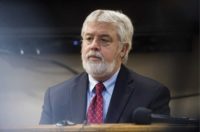The National Labor Relations Board said July 21 that an Indiana union has the right to display a 12-ft-tall inflatable rat named Scabby, along with provocative banners, outside an Indiana trade show in order to boycott Lippert Components Inc., which worked with another company involved in a labor dispute.
A banner displayed outside the trade show by a local faction of the International Union of Operating Engineers read: "Shame on Lippert Components, Inc. for harboring rat contractors."
The NLRB, in a 3-1 decision, upheld a pair of Obama-era rulings that said displaying banners and large inflatable figures such as Scabby does not violate the National Labor Relations Act's ban on threatening or coercive conduct during union boycotts.
NLRB Chair Lauren McFerran, a Democrat appointed in January by President Biden, wrote that the board decided the potential infringement of a union's free-speech right precluded a previous finding that banners and inflatable rats were illegal. Republican NLRB Members Marvin Kaplan and John Ring, while concurring with McFerran's opinion, wrote that while the conduct of the IUOE local was lawful, board decisions issued in 2010 and 2011 were too broad and could shield coercive activities by unions.
A third Republican member of the board, William Emanuel, dissented strongly from the ruling, saying the Obama-era precedent was flawed because it applied too narrow a reading of the National Labor Relations Act's ban on threats and coercion. He also said that it incentivized unions to engage in conduct that should be prohibited.
Secondary Protests
Known as "secondary protests," the use of banners and inflatables against companies who employ third parties being boycotted by labor unions and that are not the subject of labor actions themselves, has long divided the board and the Republican and Democrat administrations that appoint its members. Construction trade groups universally panned the decision.
"The NLRB decision reaffirming the status quo is disappointing to the construction industry because it allows unions to continue to engage in coercive tactics towards neutral parties, contrary to the intent of federal labor laws," said Ben Brubeck, Associated Builders and Contractors' vice president of regulatory, labor and state affairs.
"We generally agreed with NLRB member Emanuel’s dissenting opinion. Scabby and other union balloon creatures are examples of threatening and/or coercive conduct during union pickets and boycotts and should constitute secondary activity," Brubeck said.
NLRB's former general counsel, Peter Robb, an appointee of President Trump, had argued in the Lippert case that inflatables and provocative banners were unlawful. President Biden fired Robb on his first day in office in January. His replacement, Obama-era deputy general counsel Jennifer Abruzzo, was confirmed on July 21 just as this decision was handed down.
The IUOE and North America's Building Trade Unions did not immediately return requests for comment about the decision, but major unions, other labor groups and left-leaning advocacy groups involved in the case, including the American Civil Liberties Union, applauded the decision.
The Associated General Contractors of America—which joined ABC, the U.S. Chamber of Commerce and other business groups in filing amicus briefs against the use of banners and inflatables in secondary protests—explained that the reasoning behind the decision is narrow, and that's why the industry group supported a broader reading of secondary protests.
"The NLRB, during the Obama administration, established a relatively lenient standard for assessing the lawfulness of union bannering and displays of Scabby the rat," said Denise Gold, AGC associate general counsel specializing in labor issues. "They basically apply the same standards that applies to peaceful hand-billling; that's what they equated it to, as opposed to the more stringent standard that applies to picketing."
Gold said that the use of characters such as Scabby and large banners does not fall squarely within the definition of picketing, which leaves the definition of their use up to the board to interpret the NLRA and determine where this type of conduct falls and which standards should apply. While the Trump administration's NLRB, under Robb, had sought to define the activity as something beyond the hand-billing standard, this decision reaffirms that Obama-era definition.





